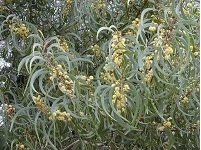Analgesic, anti-inflammatory and antipyretic properties of Acacia suma stem bark
Keywords:
Acacia suma stem bark, Acute toxicity study, Tail flick method, Freund’s adjuvant arthritis, Brewer’s yeast induced pyrexiaAbstract
Acacia suma (Fabaceae) is a medium sized erect tree found in the greater part of India. Present study was carried out for evaluation of ethanolic extract of stem bark of Acacia suma (EEAS) at 200 and 400 mg/kg, p.o. for analgesic, anti-inflammatory and antipyretic activity. EEAS was screened for analgesic activity by writhing, tail flick, tail immersion and hot plate method in mice. The anti-inflammatory activity by acute carrageenan induced paw oedema and chronic Freund’s adjuvant arthritis models in rats. The antipyretic activity was evaluated using Brewer’s yeast induced pyrexia in rabbits. Acute toxicity in mice was found to be higher than 2000 mg/kg., p.o. Analgesic activity revealed that test dose of 400 mg/kg, p.o., had significant activity in various tested models. Anti-inflammatory studies at 200 and 400 mg/kg., p.o., of extract showed significant activity (P<0.01). The extract showed significant (P<0.01) effect on yeast-induced fever in rabbits in dose dependant manner. Preliminary phytochemical tests revealed presence of carbohydrates, tannins, alkaloids, saponins and phenolic compounds in the ethanol extract of A. suma bark. The present study therefore provides scientific base for its use in the folklore remedies as an analgesic, anti-inflammatory and antipyretic properties of natural origin.
References
Pushpangadan P, and George V. Ethnomedical practice of rural and tribal population of India with special reference to the mother and childcare Indian Journal of Traditional Knowledge. 2010; 9(1):9-17.
Gupta VK, and Arya V. A review on potential diuretics of India medicinal plants.
Journal of Chemical and Pharmaceutical Research. 2011; 3(1):613-620.
Kiritikar KR, and Basu BD. Indian Medicinal Plants. Vol- II, Lalit Mohan Basu. Allahabad. India. 1933;p.935.
Anonymous. The wealth of India. Vol. I. CSIR Publishers. New Delhi, 1985; p.42 and 305-308.
Anonymous., Orissa review. Biju Patnaik Medicinal Plants Garden Research Centre, Jeypore. 2005; p.51-54.
Rastogi RP, and Mehrota BN. Compendium of Indian medicinal plants. Vol. II. Publication and Information Directorate: CDRI, New Delhi. 1933;p. 4-5.
Acharyya S, Dash GK, Mondal S, Acharyya A, and Dash SK. Studies on the hypoglycaemic activity of Acacia suma (Roxb.) barks International Journal of Chemical and Analytical Science. 2010; 1(1):10-13.
Mondal S, Parhi R, Suresh P, and Dash GK. Studies on diuretics and laxative activity of Acacia suma (Roxb) barks. International Journal of Research in Ayurveda and Pharmacy. 2010;1(2): 510-514.
Nobutomo K, Ikarashi, Rumi T, Kiyomi I, Wataru Ochiai, Kiyoshi. The inhibition of lipase and glucosidase activities by Acacia Polyphenol. Evidence-Based Complementary and Alternative Medicine. 2011; 1-8.
Wadhba SK, and Elkheir YM. Dimethyl tryptamine from the leaves of certain Acacia species of Northern Sudan. Lloydia. 1975;38(3):176-177.
Gandhi P. New proanthocyanidine from stem bark of Acacia suma. Experientia. 1977; 33(10):1272.
Ayub SMH. Flavonol molluscicides from the Sudan acacias. International Journal of Crude Drug Research. 1985; 23(2):87-90
Harborne JB. Phytochemical method: A guide to modern techniques of plant analysis. Edn. 2., Chapman and Hall, New York, 1984;p-85.
Ganapaty S, Dash GK, Subburaju T, and Suresh P. Diuretic, Laxative and toxicity studies of Cocculus Hirsutus aerial parts. Fitoterapia. 2002;73:28-31.
Bose A, Mondal S, Gupta GK, Ghosh T, Dash GK, Si S. Analgesic, anti-inflammatory and antipyretic activities of the ethanolic extract and its fractions of Cleome rutidosperma. Fitoterapia. 2007;78:515–520
Mondal S, Dash GK, Acharyya S, and Brahma, DK. Analgesic, anti-inflammatory and antipyretic studies of Cleome rutidosperma DC. Roots. Journal of Pharmacy Research. 2009; 2(2):819-822.
.Saraswathi R, Upadhyay L, Venkatakrishnan R, Meera R, Devi P. Phytochemical investigation, analgesic and anti inflammatory activity of Abutilon indicum Linn. International Journal of Pharmacy & Pharmaceutical Sciences. 2011; 3(1):154-156.
Reanmongkol W, Itharat A, and Bouking P. Investigation of the anti-inflammatory, analgesic and antipyretic activities of the extracts from the rhizome of Dioscorea membranacea Pierre in experimental animals. The Songklanakarin Journal of Science and Technology. 2007; 29:49-57.
Hoareau L, and Dasilva E. Medicinal plants: a re-emerging health aid. Electronic Journal of Biotechnology. 1999;2(2):56-70.
Ronaldo AR, Mariana LV, Sara MT, Adrriana BPP, Steve P, Ferreira SH, and Fernando Q.C. Involvement of resident macrophages and mast cells in the writhing nociceptive response induced by zymosan and acetic acid in mice. European Journal of Pharmacology. 2000;387:111–118.
Whittle BA. The use of changes in capillary permeability in mice to distinguish between narcotic and non-narcotic analgesics. British Journal of Pharmacology and Chemotherapy. 1964;22(2):246-253.
Vinegar R, Schreiber W, and Hugo R. Biphasic development of carrageenan edema in rats. Journal of Pharmacology and Experimental Therapeutics. 1969;166(1):96-103.
Crunkhorn P, and Meacock SC. Mediators of the inflammation induced in the rat paw by carrageenan. British Journal of Pharmacology. 1971;42(3):392-402.



